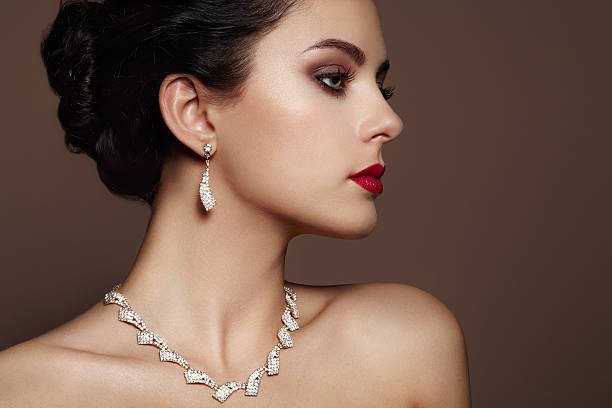When shopping for quality jewelry, you’ll often encounter two popular options: sterling silver and gold-plated pieces. Both offer beautiful aesthetics and excellent value, but they serve different needs and come with distinct characteristics. Understanding the differences between these two options will help you make an informed decision that aligns with your style, budget, and lifestyle.
In this comprehensive guide, we’ll break down everything you need to know about sterling silver and gold-plated jewelry so you can choose the perfect pieces for your collection.
Understanding Sterling Silver
What Is Sterling Silver?
Sterling silver is an alloy consisting of 92.5% pure silver and 7.5% other metals, typically copper. This composition is marked as “925” on jewelry, which has become the international standard for quality silver jewelry. The addition of other metals is necessary because pure silver (99.9% silver) is too soft for jewelry—it would bend, scratch, and lose shape easily.
The 7.5% alloy component provides the strength and durability needed for everyday wear while maintaining the lustrous appearance that makes silver so desirable.
Characteristics of Sterling Silver
Color and Appearance: Sterling silver has a bright, white metallic sheen that many people find elegant and versatile. It has a cooler tone compared to gold, making it an excellent choice for those who prefer a more modern or understated look.
Durability: Thanks to its alloy composition, sterling silver is quite durable and suitable for everyday jewelry. However, it is softer than gold and can scratch over time, though these scratches often contribute to a desirable patina that many collectors appreciate.
Tarnishing: The primary characteristic to be aware of with sterling silver is its tendency to tarnish. When exposed to air, moisture, and certain chemicals, sterling silver oxidizes and develops a dark discoloration. The good news is that tarnish is purely cosmetic and can be easily removed with proper cleaning.
Pros of Sterling Silver
- Affordability: Significantly less expensive than solid gold while still offering quality and elegance
- Hypoallergenic: Generally safe for sensitive skin (though those with severe metal allergies should note the copper content)
- Versatility: The neutral color complements virtually any outfit or style
- Durability: Solid metal throughout means no plating to wear off
- Timeless appeal: Never goes out of style
- Easy maintenance: Can be polished and cleaned repeatedly without damage
- Resale value: Maintains inherent metal value
Cons of Sterling Silver
- Requires maintenance: Needs regular cleaning to prevent and remove tarnish
- Can scratch: Softer than gold and more prone to surface scratches
- Limited color options: Only available in silver tones
- May not suit all skin tones: Some people feel silver doesn’t complement their complexion as well as gold
Understanding Gold-Plated Jewelry
What Is Gold-Plated Jewelry?
Gold-plated jewelry consists of a base metal (often brass, copper, or sterling silver) covered with a thin layer of gold through a process called electroplating. The gold layer is typically measured in microns, with quality pieces featuring plating between 1-3 microns thick. Higher-quality gold plating (sometimes called “heavy gold plating”) can be 5 microns or more.
The gold used in plating can vary in purity, commonly available in 14K, 18K, or 24K gold. Gold-plated sterling silver combines the benefits of both metals—a durable, quality base with the luxurious appearance of gold.
Characteristics of Gold-Plated Jewelry
Color and Appearance: Gold plating offers the warm, luxurious glow of gold at a fraction of the cost of solid gold jewelry. It’s available in various gold tones, including yellow gold, rose gold, and white gold, allowing for more color versatility than sterling silver.
Durability: The durability of gold-plated jewelry depends largely on the quality of the plating and the base metal. Gold-plated sterling silver is generally more durable than gold-plated brass or copper because the base metal is stronger and higher quality.
Longevity: The gold plating will wear away over time, especially in areas of high friction like the inside of rings or bracelet clasps. The rate of wear depends on the plating thickness, how often you wear the piece, and how well you care for it. With proper care, quality gold plating can last several years.
Pros of Gold-Plated Jewelry
- Affordable luxury: Achieves the gold look at a much lower price point
- Color variety: Available in yellow, rose, and white gold tones
- Trendy and fashionable: Allows you to experiment with current trends without major investment
- Warm appearance: Gold tones complement many skin tones beautifully
- Less maintenance: Doesn’t tarnish like silver (though the base metal may if plating wears through)
- Ideal for special occasions: Great for event-specific jewelry that won’t be worn daily
- When on sterling silver: Combines quality base with beautiful appearance
Cons of Gold-Plated Jewelry
- Limited lifespan: Gold layer will eventually wear away
- Cannot be re-polished: Aggressive polishing removes the gold layer
- May expose base metal: Wear can reveal different colored metal underneath
- Requires careful handling: More susceptible to damage from chemicals and friction
- Inconsistent quality: Quality varies widely depending on plating thickness and base metal
- No intrinsic gold value: Contains minimal actual gold content



